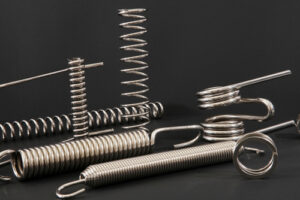 Though there are many types of metal springs engineered for products and applications, the majority of them are designed to serve one of 4 functions when a mechanical force is applied—compressive, tensile, torque, or counterbalance. As a result, it’s more than likely that designers and engineers will look for a custom solution with a compression, extension, torsion, or constant force type of metal spring. Here’s why:
Though there are many types of metal springs engineered for products and applications, the majority of them are designed to serve one of 4 functions when a mechanical force is applied—compressive, tensile, torque, or counterbalance. As a result, it’s more than likely that designers and engineers will look for a custom solution with a compression, extension, torsion, or constant force type of metal spring. Here’s why:
Compression
By far the most common type of spring is the compression spring. Found in countless applications, compression springs, as the name suggests, are those familiar coiled springs that provide resistance when compressed by an external force. Compression creates the mechanical energy required to carry a load. Thus, compression springs are designed to hold weight or absorb a force through resistance. They shrink in size upon receiving a force. Remove the force and the spring will expand, releasing its stored mechanical energy.
A defining characteristic of a compression spring is the visible spaces between the coil. Referred to as the pitch, when the distance between the coils gets smaller mechanical energy is stored until the force is removed and the spring expands to its original size. To operate effectively, a compression spring’s coils must never contact each other. Coils that touch indicate that the load is either too heavy, which relates to a design flaw, or that the spring has failed and its service life has ended.
Compression springs are manufactured in a variety of configurations, shapes, and sizes—conical, hourglass or barrel, for example—depending on the application, and provide the necessary force for such components like shock absorbers, and vibration dampeners, pure energy accumulators, or force generators.
Extension
Extension springs, also referred to as tension springs, operate on the principle of tension. In contrast to compression springs, extension springs tightly wound helical coils have no pitch between them. They are designed with hooks or loops on both ends of the spring that are attached to other components within a mechanical assembly. When the components are pulled apart, the spring expands and creates a resistance to the pulling force. Once the pulling force is released, the components return to their original position within the assembly.
As a result, the spring’s mechanical energy is derived from the tension that occurs when it is stretched, pulled or elongated. The tighter the coils are, the greater resistance and tensile force when pulled. As resistance grows and tension mounts against this pulling force, mechanical energy within the coil is stored. When the tension is removed, the spring releases its mechanical energy and snaps back to its original position.
Extension springs are used in automotive interiors and exteriors, carburetors, trampolines, garage door assemblies, vise-grip pliers, washing machines, farm machinery, toys, and so forth. Visible signs of pitch between the coils mean the spring’s service life has ended.
Torsion
Torsion springs are a type of flat spiral coil-shaped spring used for applying torque or rotational energy. Unlike compression or extension springs that require a linear force to push or pull, torsion springs utilize torque. A torsion spring rotates on its axis when a load is applied or resisted—its mechanical energy is stored and released via that rotational force or twisting action.
Torsion springs then, are found in mechanical assemblies that require rotational or torque force, such as hinges, counterbalances or lever return applications. They are generally mounted at three or more points to facilitate the mounting. Common applications for torsion springs include automobile doors, agricultural equipment assemblies, tailgates on pickup trucks, and industrial heavy-duty equipment. They are also found in everyday applications such as screen door hinges, window shades, mouse traps, ratchets, levers, clothes pins, clipboards, and garage doors.
Constant Force
Unlike traditional helical-wound springs, constant-force springs differ in design and function. They exert a consistent linear force or torque that remains constant over a large range of motion. Thus, constant-force springs are found in applications that typically require some kind of counterbalancing or retraction mechanism. They are fabricated from high yield, thin strips of pre-tensioned stainless steel spring wire which is coiled into a flat spiral. As the flattened strip is uncoiled, its energy is stored within the strip. The flat spiral design permits large angular deflections of numerous revolutions, but only uses a small part of the full extension.
Though classified as a type of extension spring, the most common constant-force spring is a spiral wound torsion spring, which can be designed to either produce a consistent force over a linear motion or manufactured to exert a constant torque. The flattened spiral strip can be coiled either in on itself or moved in the opposite direction onto another spool.
Constant-force springs are found in mechanical devices that have long-motion functions. This would include counterbalances, automated door closers, and feed mechanisms for floor dispensers and automated machinery. Retracting hoses, cords, tool head returns, seat belts, and gym equipment as well as hairdryers, toys, electric motors, and various appliances all use constant-force springs to function.
James Spring and Wire Company is a leading designer and manufacturer of standard and custom springs. Housed in a state-of-the-art spring manufacturing facility, we specialize in custom spring design with the capabilities to meet the specifications for the most challenging spring applications. For generations, we have provided fabricators, engineers, and manufacturers with the best spring for their OEM products. Looking for a custom spring solution for your product? Contact James Spring and Wire Company today to discuss your custom spring application requirements.

